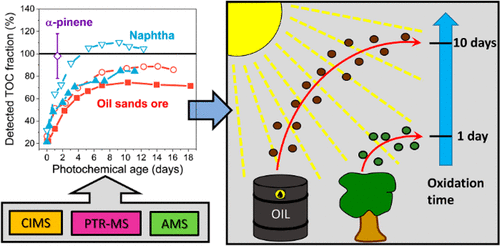当前位置:
X-MOL 学术
›
Environ. Sci. Technol.
›
论文详情
Our official English website, www.x-mol.net, welcomes your
feedback! (Note: you will need to create a separate account there.)
Evolution of Atmospheric Total Organic Carbon from Petrochemical Mixtures
Environmental Science & Technology ( IF 10.8 ) Pub Date : 2021-09-16 , DOI: 10.1021/acs.est.1c02620 Kun Li 1, 2 , Jeremy J B Wentzell 1 , Qifan Liu 1 , Amy Leithead 1 , Samar G Moussa 1 , Michael J Wheeler 1 , Chong Han 1 , Patrick Lee 1 , Shao-Meng Li 3 , John Liggio 1
Environmental Science & Technology ( IF 10.8 ) Pub Date : 2021-09-16 , DOI: 10.1021/acs.est.1c02620 Kun Li 1, 2 , Jeremy J B Wentzell 1 , Qifan Liu 1 , Amy Leithead 1 , Samar G Moussa 1 , Michael J Wheeler 1 , Chong Han 1 , Patrick Lee 1 , Shao-Meng Li 3 , John Liggio 1
Affiliation

|
Reactive organic compounds play a central role in the formation of ozone and secondary organic aerosols. The ability to accurately predict their fate, in part, relies upon quantitative knowledge of the chemical and physical parameters associated with the total organic carbon (TOC), which includes both precursors and oxidation products that evolve in the atmosphere over short to long time scales. However, such knowledge, obtained via limited carbon closure experiments, has not been attained for complex anthropogenic emissions. Here we present the first comprehensive characterization of TOC in the atmospheric oxidation of organic vapors from light and heavy oil mixtures associated with oil sand operations. Despite the complexity of the investigated oil mixtures, we are able to achieve carbon closure (83–116%) within the uncertainties (±20%), with the degree of the closure being dependent upon the vapor composition and NOx levels. In contrast to biogenic precursors (e.g., α-pinene), the photochemical time scale required for a largely complete oxidation and evolution of chemical parameters is very long for the petrochemical vapors (i.e., ∼7–10 days vs ∼1 day), likely due to the lower initial precursor reactivity. This suggests that petrochemical emissions and their impacts are likely to extend further spatially than biogenic emissions, and retain more of their complex composition and reactivity for many days. The results of this work provide key parameters to regional models for further improving the representation of the chemical evolution of petrochemical emissions.
中文翻译:

来自石化混合物的大气总有机碳的演变
反应性有机化合物在臭氧和二次有机气溶胶的形成中起着核心作用。准确预测其命运的能力部分依赖于与总有机碳 (TOC) 相关的化学和物理参数的定量知识,其中包括在短到长的时间尺度内在大气中演化的前体和氧化产物。然而,通过有限的碳封闭实验获得的这些知识尚未用于复杂的人为排放。在这里,我们首次全面表征了与油砂作业相关的轻油和重油混合物中有机蒸气的大气氧化过程中的 TOC。尽管所研究的油混合物很复杂,但我们能够在不确定性 (±20%) 内实现碳封闭 (83-116%),x级。与生物前体(例如,α-蒎烯)相比,石化蒸气的化学参数基本完全氧化和演化所需的光化学时间尺度非常长(即,~7-10 天对~1 天),可能由于较低的初始前体反应性。这表明石化排放及其影响可能比生物排放在空间上延伸得更远,并在许多天里保留更多的复杂成分和反应性。这项工作的结果为区域模型提供了关键参数,以进一步改善石化排放化学演变的表征。
更新日期:2021-10-06
中文翻译:

来自石化混合物的大气总有机碳的演变
反应性有机化合物在臭氧和二次有机气溶胶的形成中起着核心作用。准确预测其命运的能力部分依赖于与总有机碳 (TOC) 相关的化学和物理参数的定量知识,其中包括在短到长的时间尺度内在大气中演化的前体和氧化产物。然而,通过有限的碳封闭实验获得的这些知识尚未用于复杂的人为排放。在这里,我们首次全面表征了与油砂作业相关的轻油和重油混合物中有机蒸气的大气氧化过程中的 TOC。尽管所研究的油混合物很复杂,但我们能够在不确定性 (±20%) 内实现碳封闭 (83-116%),x级。与生物前体(例如,α-蒎烯)相比,石化蒸气的化学参数基本完全氧化和演化所需的光化学时间尺度非常长(即,~7-10 天对~1 天),可能由于较低的初始前体反应性。这表明石化排放及其影响可能比生物排放在空间上延伸得更远,并在许多天里保留更多的复杂成分和反应性。这项工作的结果为区域模型提供了关键参数,以进一步改善石化排放化学演变的表征。











































 京公网安备 11010802027423号
京公网安备 11010802027423号